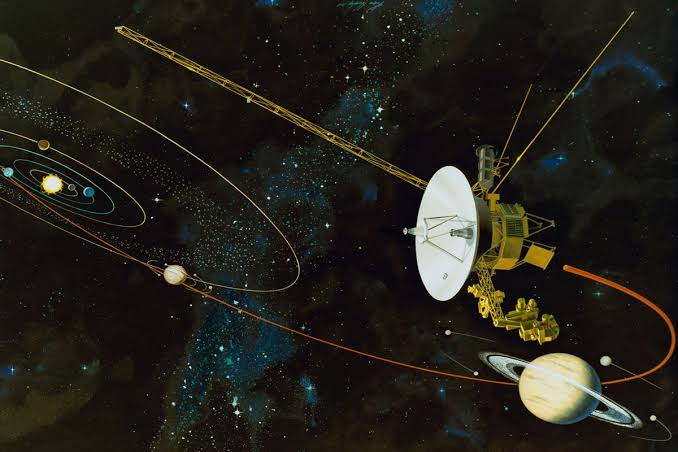- Voyager 1 was designed to take advantage of a rare planetary alignment that would allow it to use the gravity of Jupiter and Saturn to slingshot to the outer planets and beyond. It carried 11 instruments to study the planets, their moons, their rings, their magnetic fields, and the interstellar medium.
- Voyager 1's first encounter was with Jupiter, the largest planet in the solar system. It flew by Jupiter on March 5, 1979, at a distance of 349,000 km (217,000 mi). It captured stunning images of Jupiter's atmosphere, its Great Red Spot, its four Galilean moons, and its faint ring system. It also discovered two new moons, Thebe and Metis, and volcanic activity on Io.
- Voyager 1's next destination was Saturn, the ringed planet. It approached Saturn on November 12, 1980, at a distance of 124,000 km (77,000 mi). It revealed the complex structure and dynamics of Saturn's rings, as well as the atmospheres and surfaces of its moons. It also made the first close-up observations of Titan, Saturn's largest moon, which has a thick nitrogen-rich atmosphere.
- After Saturn, Voyager 1's trajectory took it out of the plane of the ecliptic, the region where most planets orbit the Sun. It was then on a course to leave the solar system and enter interstellar space. It continued to send back data on the heliosphere, the bubble of charged particles and magnetic fields created by the Sun.
- On February 14, 1990, Voyager 1 turned its camera back to the solar system and took a series of images known as the "Family Portrait". One of these images, showing Earth as a pale blue dot, became famous as a symbol of our place in the cosmos.
- On August 25, 2012, Voyager 1 crossed the heliopause, the boundary where the solar wind gives way to the interstellar medium. It became the first human-made object to enter interstellar space. It is now exploring the properties and environment of this vast and unknown region.
- Voyager 1 is still communicating with Earth through the NASA Deep Space Network. It is expected to operate until at least 2025, when its radioisotope thermoelectric generators will no longer provide enough power for its instruments. It will then continue to drift in the interstellar space, carrying a golden record that contains sounds and images of Earth and humanity, as a message to any possible alien civilization that might encounter it. ounter it. Voyager 2 is a NASA spacecraft that was launched in 1977 to explore the outer planets of our solar system and beyond. It is the second of the two Voyager probes, and the only one to visit all four of the giant planets: Jupiter, Saturn, Uranus, and Neptune. It also entered interstellar space in 2018, becoming the second human-made object to do so after its twin, Voyager 1.
Voyager 2 is a NASA spacecraft that was launched in 1977 to explore the outer planets of our solar system and beyond. It is the second of the two Voyager probes, and the only one to visit all four of the giant planets: Jupiter, Saturn, Uranus, and Neptune. It also entered interstellar space in 2018, becoming the second human-made object to do so after its twin, Voyager 1.
- Launch: Voyager 2 was launched on August 20, 1977, from Cape Canaveral, Florida, on a Titan IIIE-Centaur rocket¹. It weighed 721.9 kilograms (1,592 pounds) and carried 11 scientific instruments to study the planets and their environments.
- Jupiter flyby: Voyager 2 reached Jupiter on July 9, 1979, after 22 months of travel. It flew by the planet at a distance of 570,000 kilometers (350,000 miles) and returned stunning images and data of Jupiter and its moons. It discovered a 14th moon, called Adrastea, and observed volcanic activity on Io.
- Saturn flyby: Voyager 2 continued its journey to Saturn, arriving on August 26, 1981. It passed by the ringed planet at a distance of 101,000 kilometers (63,000 miles) and collected more information about Saturn and its moons. It confirmed the existence of a thick atmosphere on Titan, and detected complex structures and gaps in the rings.
- Uranus flyby: Voyager 2 became the first and only spacecraft to visit Uranus on January 24, 1986. It flew by the planet at a distance of 81,500 kilometers (50,600 miles) and revealed many surprises about Uranus and its moons. It discovered 10 new moons, two new rings, and a tilted magnetic field. It also found that Uranus rotates on its side and has a very cold and windy atmosphere²³.
- Neptune flyby: Voyager 2 completed its grand tour of the outer planets by reaching Neptune on August 25, 1989. It flew by the planet at a distance of 4,950 kilometers (3,080 miles) and captured stunning images and data of Neptune and its moons. It discovered five new moons, four new rings, and a Great Dark Spot, a huge storm similar to Jupiter's Great Red Spot. It also observed geysers on Triton, Neptune's largest moon.
- Interstellar mission: After leaving Neptune, Voyager 2 headed towards the edge of the solar system, where the Sun's influence ends and interstellar space begins. It crossed the termination shock, where the solar wind slows down, in 2007, and the heliopause, where the solar wind ends, in 2018. It entered interstellar space on December 10, 2018, joining Voyager 1 as the second human-made object to do so.
- Current status: Voyager 2 is still operating and communicating with Earth through the NASA Deep Space Network. It is currently about 19.9 billion kilometers (12.4 billion miles) from Earth, traveling at a speed of about 15.4 kilometers per second (34,390 miles per hour). It is expected to keep sending back data until at least 2025, when its radioisotope thermoelectric generators will no longer provide enough power for its instruments 


You must be logged in to post a comment.